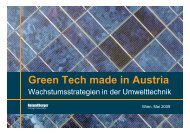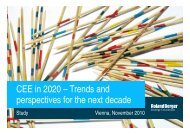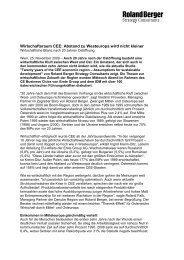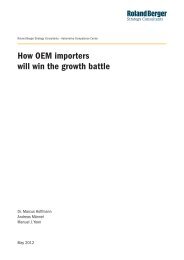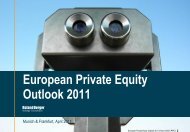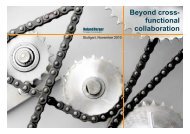Here you can download the study "From Pioneer - Roland Berger
Here you can download the study "From Pioneer - Roland Berger
Here you can download the study "From Pioneer - Roland Berger
You also want an ePaper? Increase the reach of your titles
YUMPU automatically turns print PDFs into web optimized ePapers that Google loves.
<strong>From</strong> <strong>Pioneer</strong> to Mainstream<br />
Evolution of wind energy markets and implications for<br />
manufacturers and suppliers<br />
Hamburg/Wien, März 2010<br />
WindpowerChallenges2010-1.pptx
Contents Page<br />
A<br />
B<br />
Continuous growth and maturing of <strong>the</strong> wind energy market<br />
expected<br />
Wind turbine manufacturers will need to get large and<br />
industrially lean – Suppliers will have to follow suit<br />
© 2010 <strong>Roland</strong> <strong>Berger</strong> Strategy Consultants GmbH WindpowerChallenges2010-1.pptx 2<br />
3<br />
20
A. Continuous growth and maturing of <strong>the</strong> market<br />
expected<br />
WindpowerChallenges2010-1.pptx<br />
3
1<br />
Due to its technological maturity wind will continue to take a<br />
major part of <strong>the</strong> growth market in <strong>the</strong> next decade<br />
∑ 4,100 GW<br />
+60%<br />
∑ 6,500 GW<br />
GLOBAL MARKET<br />
2007<br />
2020<br />
970 GW<br />
242 GW<br />
x~4<br />
Renewables RenewablesGas<br />
Large Hydro Coal Nuclear<br />
Examples<br />
Global capacity<br />
[GW]<br />
Long-term feasible<br />
potential worldwide<br />
[GW]<br />
Revenue potential<br />
(in 2020)<br />
Current technology<br />
maturity<br />
Wind Solar Marine energy<br />
2008 2020 2008 2020 2008 2020<br />
120 600 15 157 0.3 1.2<br />
2,000-6,000 50,000-80,000 3,000-6,000<br />
EUR 90-110 bn EUR 50-80 bn EUR 0.5-2.0 bn<br />
Current cost per MWh EUR 50-80 EUR<br />
100-270<br />
Source: E.on; IEA; BTM; California Institute of Technology; World Energy Council, World Energy Assessment; NEF; RBSC<br />
Solar PV Solar <strong>the</strong>rmal (CSP)<br />
EUR<br />
145-200<br />
EUR 190-270<br />
WindpowerChallenges2010-1.pptx<br />
4
1 GLOBAL MARKET<br />
Governments are establishing ambitious investment and<br />
growth plans for wind energy all over <strong>the</strong> world<br />
Worldwide actual and potential wind power capacity 2008-2020 [GW]<br />
North America<br />
+131<br />
38<br />
169<br />
Installed Potential<br />
2009 2020<br />
Source: EER, EWEA, GWEC<br />
Europe<br />
+126<br />
76<br />
202<br />
Installed Potential<br />
2009 2020<br />
2<br />
RoW<br />
+14<br />
16<br />
Installed Potential<br />
2009 2020<br />
Asia/Pacific<br />
+148<br />
41<br />
189<br />
Installed Potential<br />
2009 2020<br />
TOP GROWTH MARKETS<br />
EU countries<br />
> Proposed target of 20% of renewable energy sources by 2020 – wind<br />
contributing to 11-14% of electrical energy with 180 GW, including 40<br />
GW offshore<br />
> Total investments between 2011-2020 accounting for EUR 120 bn<br />
USA<br />
> Proposed target of 20% wind power by 2030<br />
> Economic stimulus bill including USD bn ~67 for clean energy,<br />
including extension of production tax credits and offering of investment<br />
tax credits<br />
> Investment plans include initiatives for <strong>the</strong> transmission system which<br />
constrains <strong>the</strong> wind energy growth today<br />
CHINA<br />
> 3% target of non-hydro renewable electricity production by 2020 –<br />
120 GW of wind power capacity by 2020<br />
> "10 GW Size Wind Base" program planning large scale deployment of<br />
10 GW of wind power in four key regions until 2020<br />
INDIA<br />
> Government plans for wind power capacity of 40 GW by 2022<br />
> Offshore wind, currently untapped in India, has signifi<strong>can</strong>t potential –<br />
India has 7,000 miles of coast line<br />
WindpowerChallenges2010-1.pptx<br />
5
Austrian wind power capacity remained unchanged in 2009 –<br />
Large ramp-up of capacity expected in <strong>the</strong> coming five years<br />
Overview of <strong>the</strong> Austrian Wind Power Capacity<br />
Map of Austrian wind parks 1) in 2008<br />
1,000-1,500 KW >1,500 KW<br />
Bregenz<br />
Province<br />
Lower Austria<br />
Burgenland<br />
Styria<br />
Upper Austria<br />
O<strong>the</strong>r<br />
Total<br />
Innsbruck<br />
MW<br />
572.64<br />
371.23<br />
65.35<br />
27.33<br />
11.25<br />
1,047.80<br />
3)<br />
Salzburg<br />
Villach<br />
Krems<br />
Linz<br />
Wien<br />
St. Pölten<br />
Steyr<br />
Wiener Neustadt<br />
Liezen<br />
Klagenfurt<br />
# Wind Parks<br />
117<br />
32<br />
16<br />
10<br />
15<br />
190<br />
Kapfenberg<br />
Leoben<br />
Source: <strong>Roland</strong> <strong>Berger</strong>; Austrian Wind Power Energy Association; E-Control; Global Wind Energy Council; OeMag<br />
Graz<br />
# Wind Turbines<br />
460<br />
209<br />
52<br />
30<br />
14<br />
765<br />
Development of <strong>the</strong> total Austrian nameplate wind<br />
power capacity 2005-2014 [MW] 2)<br />
2,000<br />
1,500<br />
1,000<br />
1) Excl. wind parks with less than 1,000 KW 2) Only parks with OeMag contracts 3) Incl. Parks without OeMag contracts<br />
0<br />
MW<br />
819<br />
965<br />
982<br />
995<br />
1,575 1,695<br />
1,575<br />
1,365<br />
1,155<br />
995 1,015<br />
Projected development<br />
2005 2006 2007 2008 2009 2010 2011 2012 2013 2014<br />
> According to <strong>the</strong> Austrian Renewable Energy Act <strong>the</strong><br />
targeted increase in wind power effect 2009-2014 is<br />
700 MW<br />
> No capacity was installed in 2009 – large build-up<br />
expected in 2012 and 2013 due to long lead times<br />
WindpowerChallenges2010-1.pptx<br />
6
With <strong>the</strong> recent increase of <strong>the</strong> wind power supplier subsidy,<br />
<strong>the</strong> targeted increase in wind power capacity is realistic<br />
Average Austrian renewable energy supplier subsidies 2003-2009<br />
Cent/kWh<br />
18<br />
16<br />
14<br />
12<br />
10<br />
8<br />
6<br />
4<br />
0<br />
11.4<br />
8.6<br />
7.6<br />
4.4<br />
2003<br />
3.0<br />
12.6<br />
9.2<br />
7.7<br />
4.4<br />
3.5<br />
2004<br />
Source: <strong>Roland</strong> <strong>Berger</strong>; E-Control; OeMag<br />
13.3<br />
10.7<br />
7.8<br />
4.6<br />
4.5<br />
2005<br />
13.7<br />
12.6<br />
7.8<br />
5.3<br />
5.2<br />
2006<br />
13.8<br />
13.3<br />
7.8<br />
5.2<br />
2007<br />
17.7<br />
13.6<br />
7.8<br />
5.6<br />
2008<br />
Biogas<br />
Biomass<br />
8.2<br />
Hydro<br />
9.7<br />
2009<br />
Wind<br />
Market price<br />
> Wind power supplier subsidies<br />
remained stable between 2003-<br />
2008<br />
> The new Austrian Renewable<br />
Energy Act resulted in a 30%<br />
increase of <strong>the</strong> wind power<br />
subsidy from 7.53 Cent/kWh to<br />
9.7 cent/kWh in 2009<br />
> The new subsidy is still slightly<br />
below <strong>the</strong> European average<br />
(10.2 cent/ kWh)<br />
The new subsidy allows for an<br />
opportunity to reach <strong>the</strong><br />
increased capacity target<br />
WindpowerChallenges2010-1.pptx<br />
7
1 GLOBAL MARKET<br />
In spite of <strong>the</strong> slowdown expected in 2010, mid term expectations<br />
for wind energy are buoyant – 12% growth p.a. until 2013<br />
Worldwide yearly added capacity [GW]<br />
28<br />
9%<br />
29%<br />
29%<br />
32%<br />
2008<br />
Source: BTM; RBSC<br />
37<br />
6%<br />
26%<br />
39%<br />
28%<br />
2009<br />
37<br />
12%<br />
23%<br />
27%<br />
37%<br />
2010e<br />
59<br />
+12% p.a. 52 15%<br />
44<br />
13%<br />
23%<br />
28%<br />
37%<br />
2011e<br />
14%<br />
25%<br />
26%<br />
36%<br />
2012e<br />
25%<br />
26%<br />
34%<br />
2013e<br />
O<strong>the</strong>r<br />
USA<br />
Asia<br />
Europe<br />
Growth trend still intact<br />
> Economic stimulus packages strongly<br />
support renewable energies, especially<br />
wind<br />
> Strong growth in 2009 mainly due to<br />
capacity going online and accounted for<br />
WTGs already delivered in 2007/2008<br />
> Slowdown in 2010 due to lower order<br />
intake and deliveries during 2009<br />
> Strong growth share in countries less<br />
dependant on financial markets (China)<br />
> Ambitious government goals for<br />
renewable energy share in core markets<br />
(e.g. USA, Europe, China, India...)<br />
> Cost penalties for fossil energies in<br />
Europe (ETS)<br />
> Offshore plans included<br />
WindpowerChallenges2010-1.pptx<br />
8
1 GLOBAL MARKET<br />
Announced economic stimulus programs will fur<strong>the</strong>r push wind<br />
energy<br />
Announced governmental clean energy stimulus spending until 2013 [USD bn]<br />
> USD 163 bn between 2009<br />
and 2013 in clean energy –<br />
70% of it in 2010-2011<br />
> By sector <strong>the</strong> stimulus target:<br />
– Efficiency 26%<br />
– Renewable industry 24%<br />
– Grid 20%<br />
– R&D 20%<br />
– O<strong>the</strong>r 15%<br />
Source: NEF<br />
66<br />
47<br />
28<br />
22<br />
163<br />
USA China Europe O<strong>the</strong>r Total<br />
WindpowerChallenges2010-1.pptx<br />
9
1 MARKET EUROPE<br />
"20-20-20" targets bind EU countries to produce 20% of <strong>the</strong>ir power<br />
with renewables – Wind best positioned to fill <strong>the</strong> supply gap<br />
Impact of <strong>the</strong> EU ETS on utilities – EU Climate and Energy Package, December 2008<br />
Europe "20-20-20" targets 2020<br />
-20% CO 2 emissions<br />
… of 1990 levels by 2020<br />
Source: EU Council; RBSC<br />
20% renewables<br />
… share of energy mix by 2020<br />
-20% energy used<br />
… of 2020 projected levels<br />
IMPACT ON UTILITIES<br />
1) Utilities in East European countries are exempted and will get 70% of <strong>the</strong>ir required certificates for free after 2013 until 2020<br />
2) Emissions Trading Scheme<br />
> Utilities are responsible for around ¾ of CO 2<br />
emissions of all branches of industry<br />
> Utilities will be allowed to emit only as much CO 2<br />
as <strong>the</strong>y have emissions allowances (certificates)<br />
> <strong>From</strong> 2013 on utilities will have to buy 100% of<br />
<strong>the</strong>ir certificates 1) in auctions and may trade<br />
<strong>the</strong>m afterwards (EU ETS 2) )<br />
> By 2020 <strong>the</strong> total number of available certificates<br />
will be reduced by 21%<br />
> A considerable number of coal-fired power plants<br />
will have to be substituted – wind is <strong>the</strong> most<br />
mature renewable source to fill <strong>the</strong> supply gap<br />
and to reach <strong>the</strong> national quotas of renewable<br />
energy<br />
WindpowerChallenges2010-1.pptx<br />
10
1 MARKET US<br />
The current legislative environment in <strong>the</strong> US is clearly in favor<br />
of growth of renewable energy market<br />
Regulatory framework<br />
AMERICAN RECOVERY AND REINVESTMENT<br />
> USD 20 bn tax incentives for clean energy<br />
> USD 8 bn available as loans for renewable energy generation<br />
and transmission projects<br />
> USD 2 bn available for clean energy R&D<br />
> Goal to unleash USD 100 bn in private sector co-investment<br />
capital<br />
> RGGI states will distribute a set amount of<br />
CO 2 allowances through regional auctions,<br />
188 million tons<br />
> Utilities will be forced to look at renewable<br />
solutions as <strong>the</strong> CO 2 allowances are<br />
decreased 10 percent by 2018<br />
CARBON REDUCTION INITIATIVE<br />
Source: Washington Post, RGGI, PEW, AWEA, RBSC<br />
Participating States<br />
Renewable energy<br />
RENEWABLE PORTFOLIO STANDARD<br />
> RPS commitments vary by state and range from 10-25% with<br />
target dates from 2010 to 2025<br />
State renewable goal<br />
Mandatory RPS<br />
> Production tax credit, PTC, was renewed for 3 years in<br />
October 2008<br />
> Investment tax credit, ITC, was extended by Congress in<br />
October 2008 for 8 years<br />
> Allow PTC or ITC to be replaced with a grant from <strong>the</strong> US<br />
Treasury Department<br />
PRODUCTION AND INVESTMENT CREDITS<br />
WindpowerChallenges2010-1.pptx<br />
11
1 MARKET CHINA<br />
The Chinese wind energy market will also continue to grow<br />
strongly – Signifi<strong>can</strong>t support of domestic manufacturers<br />
Estimation of China cumulative installed capacity 2008-2013 [GW]<br />
12<br />
2008<br />
Source: GWEC, RBSC<br />
+ 107%<br />
25<br />
2009<br />
22% p.a.<br />
55<br />
2013e<br />
COMMENTS<br />
> Ambitious 120 GW target promoted in <strong>the</strong> "Wind Base Program"<br />
planning large scale deployment in selected regions<br />
> Better resilience than western markets facing <strong>the</strong> financial crisis –<br />
Chinese wind industry’s development is mostly directed by <strong>the</strong><br />
state with 80% of <strong>the</strong> market concentrated in large state-owned<br />
enterprises<br />
> Strong promotion of domestic manufacturing – In 2008 local<br />
players accounted for 75% of China WTG market up from 30% in<br />
2004<br />
– Higher taxes for importing wind turbines and key components<br />
– Specific incentives (cash subsidies pro MW) for <strong>the</strong><br />
manufacturing of turbines for domestic brands (>51%<br />
Chinese)<br />
– 70% localization must be achieved in order to participate in<br />
supply to state-owned wind farm operators<br />
> However, local manufacturing base is currently suffering from<br />
overcapacity (over 40%) and signifi<strong>can</strong>t fragmentation<br />
WindpowerChallenges2010-1.pptx<br />
12
2 UTILITIES<br />
Wind energy production has increasingly become a large<br />
utilities game<br />
2008 Europe Top 10 wind portfolio additions [MW]<br />
Source: EER; RBSC<br />
185<br />
180<br />
225<br />
420<br />
460<br />
525<br />
Utility<br />
575<br />
715<br />
685<br />
670<br />
IPP/Investor/O<strong>the</strong>r<br />
COMMENTS<br />
> Utilities are increasingly taking over <strong>the</strong> wind industry and<br />
positioning <strong>the</strong>mselves as consolidators<br />
> Aggressive portfolio extensions through building of new<br />
capacity or acquisitions, e.g.<br />
– S&S Energy acquisition of Airtricity (327 MW)<br />
– RWE acquisition of Urvasco (148 MW)<br />
– FCC (public services company) acquisition of Babcock<br />
& Brown' wind energy assets in Spain (420 MW)<br />
– Magnum Capital (PE) acquisition of Babcock & Brown<br />
wind energy assets in Portugal (515 MW and 156 MW<br />
in construction)<br />
> Several large mergers are as well restructuring <strong>the</strong> market<br />
– Vattenfall-Nuon<br />
– RWE-Essent<br />
– GDF Suez - Electrabel<br />
WindpowerChallenges2010-1.pptx<br />
13
2 UTILITIES<br />
Six key factors are driving <strong>the</strong> utilities to fur<strong>the</strong>r increase wind<br />
in <strong>the</strong>ir portfolio, broadening <strong>the</strong>ir energy mix<br />
OIL AND GAS RISK<br />
> Oil and gas prices and supply uncertainty<br />
increases <strong>the</strong> need for utilities to reduce <strong>the</strong>ir<br />
exposure<br />
> Wind broadens <strong>the</strong> energy mix cost-effectively<br />
CRISIS "WINDOW OF OPPORTUNITY"<br />
> Problems for small and medium wind players<br />
to access financing<br />
> Acquisition of locations, equipment and know-how<br />
at low prices relying on strong cash flow from<br />
operations<br />
EU "20-20-20" TARGETS FOR 2020<br />
> Utilities are forced to auction 100% of required<br />
CO 2 certificates after 2013<br />
> Operation with CO 2-intensive energies<br />
(e.g. coal) will become more expensive<br />
Source: RBSC<br />
Utilities' growth<br />
in wind energy<br />
market<br />
> Strong focus on<br />
reliability and yield<br />
> Global supply of<br />
wind turbines<br />
> Own project<br />
management and<br />
O&M organizations<br />
SHORT LEAD TIME OF WIND<br />
> Global energy demand grows by 10-20%<br />
each year<br />
> Building a standard wind park takes only<br />
3-5 years, a much shorter lead time than that<br />
of a conventional plant<br />
PROMOTE GREEN IMAGE<br />
> General public increases awareness on<br />
environmental issues<br />
> Utilities need to promote a green image<br />
opposed to <strong>the</strong> traditional "polluter" one<br />
POLITICAL INCENTIVES<br />
> Support by political initiatives making wind<br />
energy production more attractive<br />
(e.g. tax incentives, feed-in tariffs)<br />
WindpowerChallenges2010-1.pptx<br />
14
2 UTILITIES<br />
The large scale entry of utilities will fur<strong>the</strong>r increase project<br />
size leading to framework agreements<br />
Bigger wind park projects and framework agreements<br />
TOWARDS BIGGER WIND PARK PROJECTS TOWARDS FRAMEWORK AGREEMENTS<br />
40<br />
35<br />
30<br />
25<br />
20<br />
15<br />
10<br />
5<br />
0<br />
Average number of turbines<br />
Number of farms<br />
2001 2002 2003 2004 2005 2006 2007 2008 2009 2010 2011 2012<br />
90<br />
80<br />
70<br />
> Average wind farm size increased by 20% in <strong>the</strong> last<br />
four years – larger projects over 50 MW are expected<br />
in <strong>the</strong> next years, specially offshore<br />
> Wind park size is a key factor for <strong>the</strong><br />
industrialization of wind energy<br />
Source: RBSC<br />
60<br />
50<br />
40<br />
30<br />
20<br />
10<br />
0<br />
FEWER<br />
BUT<br />
LARGER<br />
ORDERS<br />
> Harder<br />
competition<br />
among WTMs<br />
> Crucial importance<br />
of partnerships<br />
and key account<br />
management<br />
Competitors have<br />
entered into major deals<br />
with utilities<br />
> Siemens agreement<br />
with Dong Energy for<br />
1800MW<br />
> REpower will<br />
manufacture wind<br />
turbines for RWE<br />
Innogy amounting to<br />
1900 MW<br />
> Utilities are allocating large orders and<br />
establishing framework agreements with<br />
selected suppliers – partnerships focusing to<br />
develop joint growth approaches<br />
> Number of suppliers to <strong>the</strong> major utilities is<br />
reduced<br />
WindpowerChallenges2010-1.pptx<br />
15
2 UTILITIES<br />
There will be strong demands from <strong>the</strong> utilities towards<br />
systematic industrialization of <strong>the</strong> wind value chain<br />
WIND<br />
TURBINE<br />
GAS<br />
TURBINE<br />
1) Wind Turbine Generator<br />
Source: E.on<br />
Origination, development &<br />
procurement<br />
e.g.<br />
Contractual risk allocation<br />
Construction Operations & maintenance<br />
e.g.<br />
Process integration<br />
e.g.<br />
Monitoring<br />
> Suppliers provide low<br />
> Suppliers consider grid > Random monitoring<br />
guarantee level<br />
> Asymmetric contracts (e.g. 50%<br />
paid back if total WTG 1) failure)<br />
> Suppliers provide full guarantee<br />
(e.g. 100% paid back if total<br />
turbine failure)<br />
requirements out of scope<br />
> Some key offshore construction<br />
steps still not tested<br />
> Suppliers meet all grid<br />
requirements<br />
> Proven construction/installation<br />
technology<br />
> Reactive maintenance<br />
> Heavy delays in data<br />
transmission and intervention<br />
vs. vs. vs.<br />
> Full monitoring and control<br />
> Preventive maintenance<br />
WindpowerChallenges2010-1.pptx<br />
16
3 OEMs<br />
The wind turbine manufacturers' market is still heterogeneous<br />
– final structure has yet to emerge<br />
Overview WTG OEMs clusters<br />
PLAYERS<br />
Ø 2008 MW<br />
installed<br />
MARKET-<br />
SHARE 1)<br />
BACK-<br />
GROUND<br />
1) Installed capacity 2008 MW<br />
Source: RBSC<br />
LARGE INDUSTRIALS PIONEERS REGIONALS<br />
Large and established industrial<br />
corporations, which have entered <strong>the</strong><br />
WTG market mainly through<br />
acquisition<br />
?<br />
Original WTG technology developers<br />
which have not been acquired by a<br />
large industrial<br />
Unison<br />
30% 53% 17%<br />
?<br />
Regional players developing within<br />
growth markets<br />
WindpowerChallenges2010-1.pptx<br />
17
3 OEMs<br />
Fragmentation of <strong>the</strong> OEM market has been observed in <strong>the</strong><br />
past years – pioneers have been relative losers<br />
Overview market shares 2005-08 [% MW delivered]<br />
100%<br />
9%<br />
100%<br />
64% 1%<br />
6%<br />
3%<br />
2%<br />
6%<br />
14%<br />
49%<br />
<strong>Pioneer</strong>s<br />
13%<br />
18%<br />
28%<br />
2005<br />
Rest<br />
Source: BTM, EER, Companies, RBSC<br />
4%<br />
4%<br />
16%<br />
6%<br />
8%<br />
9%<br />
11%<br />
17%<br />
18%<br />
2008<br />
4%<br />
3%<br />
O<strong>the</strong>rs<br />
Sinovel<br />
Acciona<br />
Goldwind<br />
Nordex<br />
Siemens<br />
Suzlon<br />
Enercon<br />
Gamesa<br />
GE Energy<br />
Vestas<br />
REMARKS<br />
> <strong>Pioneer</strong>s market share decreased from 64% to 49%<br />
in 3 years<br />
> Large industrials as Siemens and GE lost relatively<br />
low or no market share since 2005<br />
> Strong market competition with a fragmentation of<br />
<strong>the</strong> overall <strong>the</strong> market<br />
– Small players increased market share from 9 to<br />
16% between 2005-2008<br />
– Strong growth Chinese and Ameri<strong>can</strong> markets<br />
streng<strong>the</strong>n local suppliers (e.g. China<br />
Sinovel/Goldwind and USA Clipper)<br />
WindpowerChallenges2010-1.pptx<br />
18
3 OEMs<br />
Leveraging <strong>the</strong>ir strong home base Chinese manufacturers are<br />
preparing to go global<br />
Market share of China annual installed turbine capacity<br />
Wind turbine suppliers' market share in China<br />
2008 [MW %]<br />
O<strong>the</strong>rs<br />
Nordex<br />
GE Wind<br />
8.4%<br />
Acciona<br />
2.3%<br />
Mingyang<br />
Shanghai 2.8% 2.4% 2.3%<br />
Electrics 2.9%<br />
Windey 3.7%<br />
Gamesa 8.1%<br />
Source: RBSC<br />
Vestas<br />
∑ top 3 market share:57.4%<br />
Local and JVs<br />
9.6%<br />
16.9%<br />
Dongfang Electric<br />
22.5%<br />
Sinovel<br />
18.1%<br />
Gold Wind<br />
Suppliers structure in China<br />
local<br />
Foreign<br />
JV<br />
Development stage<br />
Tier 1<br />
Tier 2<br />
Tier 3<br />
Large capacity products<br />
with licensed technology<br />
Have prototype and<br />
preliminary small<br />
production capacity<br />
Completed prototype<br />
design and plan to build<br />
Foreign companies with mature<br />
design and process technologies<br />
Leverage foreign technology<br />
Companies<br />
Gold Wind<br />
Sinovel<br />
Dongfang electrics<br />
Zhejiang Windey<br />
Xiangdian<br />
Huayi Electrics<br />
Tianwei baobian<br />
Yuanjing Energy<br />
Changzheng Electrics<br />
GE Nordex<br />
Gamesa<br />
Vestas<br />
Suzlon<br />
Acciona JV in Nantong<br />
REpower, Honiton JV<br />
WindpowerChallenges2010-1.pptx<br />
19
3 OEMs<br />
The financial crisis and <strong>the</strong> emergence of new OEM players has<br />
led to structural overcapacity – shift to a buyers' market<br />
Expected overcapacity evolution (%; 2009 – 2013)<br />
70.000 40<br />
35%<br />
60.000<br />
50.000<br />
40.000<br />
30.000<br />
20.000<br />
10.000<br />
[MW]<br />
0<br />
-1%<br />
2008<br />
Aggregated demand<br />
Source: BTM; Macquarie; RBSC<br />
2009E<br />
24%<br />
22%<br />
14%<br />
11%<br />
2010E 2011E 2012E 2013E<br />
Aggregated capacity<br />
Overcapacity<br />
30%<br />
20%<br />
10%<br />
0%<br />
-10<br />
IMPLICATIONS FOR OEMs<br />
> Short-term:<br />
– Maximize sales deals in an<br />
environment of WTG<br />
manufacturers overcapacity,<br />
ensuring '10 production and being<br />
ready for <strong>the</strong> re-launch<br />
– Maintain margins and payment<br />
conditions during current turbulent<br />
times (as far as possible; potential<br />
buyer will ask for signifi<strong>can</strong>t price<br />
reductions – from 10 to 20%)<br />
> Mid-term:<br />
– Prepare <strong>the</strong> sales organization for<br />
a "buyers' market" environment<br />
WindpowerChallenges2010-1.pptx<br />
20
CONCLUSION<br />
Conclusion: The WTG market is changing from being a<br />
"pioneering" market into a mainstream industrial market<br />
PIONEERING MARKET (UNTIL 2008)<br />
Main market growth in a few Western European markets<br />
(Germany, Spain, Denmark) – US starting with delay<br />
MAINSTREAM MARKET (EXPECTED AS OF 2011)<br />
Growth broadening to all large and non fossil fuel<br />
exporting markets (Rest of EU, USA and China)<br />
Technology development occurring in parallel to WTG<br />
Product development following standard industrial<br />
manufacture with fast evolving model ranges – bottlenecks<br />
in component development and supply capacity<br />
WTGs were mainly purchased by developers or financial<br />
investors who primed delivery capability over price<br />
WTG industry was dominated by pioneers like Vestas and<br />
Gamesa<br />
Source: RBSC<br />
"Get large and industrially lean or exit!"<br />
practices and speeds – supply chains more stable and<br />
local<br />
Utilities are increasingly becoming buyers, who apply<br />
similar price/performance criteria as for conventional<br />
generation equipment – price squeeze is expected<br />
Large industrial players (Siemens, GE) and local<br />
players (Goldwind, Sinovel, etc.) are increasing <strong>the</strong>ir<br />
market share at <strong>the</strong> expense of <strong>the</strong> early pioneers –<br />
overcapacity will trigger consolidation<br />
WindpowerChallenges2010-1.pptx<br />
21
B. Wind turbine manufactures will need to get large and<br />
industrially lean – Suppliers must follow suit<br />
WindpowerChallenges2010-1.pptx<br />
22
OEMs need to develop along four axis – support from suppliers<br />
required on all of <strong>the</strong>m<br />
OEM development needs and key requirements to suppliers along <strong>the</strong> value chain<br />
OEM<br />
DEVELOP-<br />
MENT<br />
NEEDS<br />
OEM<br />
REQUIRE-<br />
MENTS TO<br />
SUPPLIERS<br />
Source: RBSC<br />
1 LEVERAGE 2 GLOBAL<br />
3<br />
TECHNOLOGY PRESENCE<br />
> Support complex<br />
technology trade-offs<br />
focusing on life cycle<br />
costs<br />
> Support faster timeto-market<br />
for new<br />
WTGs<br />
> Contribute to<br />
standardization and<br />
modularization<br />
> Build up global<br />
operations footprint<br />
> Contribute to <strong>the</strong><br />
establishment of local<br />
supply chains on a<br />
global scale<br />
LEAN<br />
OPERATIONS<br />
> Contribute to overall<br />
profitability and cost<br />
reduction<br />
> Support fur<strong>the</strong>r<br />
flexibility and<br />
industrialization of<br />
operations along <strong>the</strong><br />
value chain<br />
> Achieve process<br />
excellence, especially<br />
for global, regional<br />
and local logistics<br />
4<br />
CAPTURE<br />
MARKET<br />
> Support OEM access<br />
to profitable key<br />
markets and clients<br />
> Support OEMs going<br />
for a a full-service<br />
value proposition<br />
WindpowerChallenges2010-1.pptx<br />
23
1<br />
TECHNOLOGY<br />
Complex technological challenges ahead – Close collaboration<br />
with supplier base is required<br />
Main technical challenges – Towards improved reliability, life-cycle-costs and yield<br />
BLADES AND ROTOR<br />
> Introduction of new materials<br />
(e.g. CFRP)<br />
> Manufacturing constraints<br />
> Endurance to environmental<br />
damage (e.g. wea<strong>the</strong>r,<br />
lighting)<br />
TOWER AND<br />
FOUNDATION<br />
> New foundations design,<br />
construction techniques and<br />
materials, specially for<br />
Offshore<br />
Source: RBSC<br />
DRIVE TRAIN AND<br />
GENERATOR<br />
> Lighter and more compact<br />
housings (e.g. integration of drive<br />
train and generator)<br />
> Simplification and new design<br />
solutions for drive trains (e.g.<br />
reduction of bearings and roller<br />
parts)<br />
> Integration of new generator<br />
technologies (e.g. superconductor<br />
generators)<br />
GRID CONNECTION &<br />
INTEGRATION<br />
> Adaptation to grid requirements<br />
(e.g. stability, voltage fluctuations)<br />
> Industrial customization and<br />
modularization of wind turbines<br />
> New integration technologies<br />
OPPORTUNITIES FOR SUPPLIERS<br />
> Position as a critical partner<br />
actively supporting OEMs<br />
overcoming complexity of<br />
technical challenges on critical<br />
components<br />
> Pursue risk sharing and<br />
partnering strategies for new<br />
developments of proprietary<br />
technology<br />
> Support reduction of<br />
manufacturing costs by<br />
establishing industrialization<br />
requirements early in <strong>the</strong><br />
development<br />
WindpowerChallenges2010-1.pptx<br />
24
1<br />
TECHNOLOGY<br />
OEMs approach for R&D is diverging – Suppliers will have to<br />
adapt <strong>the</strong>ir portfolio and capabilities to target clients<br />
Diverging OEMs approaches for R&D<br />
Source: RBSC<br />
Towards overall design<br />
authority<br />
Towards outsourcing of<br />
components design<br />
> Build-to-print design principle > Build-to-spec design principle<br />
> Own design and proprietary<br />
technology for WTG core<br />
components<br />
> Tend to more innovative solutions<br />
(e.g. materials, drive train)<br />
> Mainly use own R&D capabilities<br />
OEM<br />
R&D<br />
Selected OEMs: Selected OEMs:<br />
> Typically use of standard and of<strong>the</strong>-shelf<br />
components<br />
> Tend towards mainstream solutions<br />
> Rely on suppliers R&D capabilities<br />
WindpowerChallenges2010-1.pptx<br />
25
2<br />
GLOBAL PRESENCE<br />
Large industrial players are systematically expanding <strong>the</strong>ir<br />
footprint<br />
Example – Siemens global footprint<br />
Boulder<br />
(Wind &<br />
Ft. Madison<br />
aerodynamics) (blades)<br />
USA<br />
(planned for Orlando<br />
nacelles/hub)<br />
Supply chain Sales hubs<br />
O<strong>the</strong>r sales R&D<br />
Source: Siemens, RBSC<br />
Bremen<br />
Keele (UK, Delft (NL),<br />
Aachen (DE)<br />
(Mechanics, grid offshore)<br />
Madrid<br />
Engesvang<br />
(blades)<br />
ØIgod<br />
(hubs)<br />
Hamburg<br />
(Europe HQ)<br />
Aalborg<br />
(blades prod. & R&D<br />
blade design)<br />
India<br />
(planned) Singapore<br />
Taastrup<br />
(Aerodynamics, structural<br />
dynamics, electrical systems)<br />
China<br />
(planned for<br />
nacelle/hub/blades)<br />
Underlying rationale<br />
First:<br />
> Establish an industrially lean<br />
processes in <strong>the</strong> home base<br />
Then:<br />
> Transfer (duplicate) industrial<br />
set up to international locations<br />
Expectations towards suppliers<br />
> Follow international moves of<br />
OEMs<br />
> Implement and continuously<br />
improve lean manufacturing<br />
locally while benefiting from <strong>the</strong><br />
volumes generated by <strong>the</strong> OEM<br />
WindpowerChallenges2010-1.pptx<br />
26
2<br />
GLOBAL PRESENCE<br />
R&D capabilities and footprint are also being globalized –<br />
Vestas R&D works 24 hours a day around <strong>the</strong> globe<br />
Example – Vestas global R&D footprint<br />
Texas Research Center<br />
> Houston, Texas, USA<br />
> 80 employees<br />
> Show presence and<br />
access to knowledge in<br />
center of US wind energy<br />
> Announced in June 2008,<br />
fully operational in 2010<br />
Source: Vestas; RBSC<br />
Boston Technology Hub<br />
> Boston, Mass., USA<br />
> No. of employees to be<br />
announced<br />
> Focus on generators,<br />
converters and control<br />
technologies<br />
> Acquisition of ePower LLC<br />
(former MIT) in December 2008<br />
Technology R&D HQ<br />
> Århus, Denmark<br />
> 500 employees<br />
> Worldwide research hub<br />
India R&D Centre<br />
> Chennai, India<br />
> Currently 100 employees, planned<br />
for 500 in 2013<br />
> Streng<strong>the</strong>n Vestas R&D on a<br />
global scale<br />
> Get access to elite knowledge in<br />
India and show presence in key<br />
market<br />
> Opened in September 2008<br />
Asia R&D Centre<br />
> Singapore<br />
> 150 employees (2009),<br />
planned for 300 in 2012<br />
> Regional R&D hub<br />
> New component and subsystem<br />
development,<br />
innovation in product<br />
development<br />
> Opened in November<br />
2008<br />
Challenges of global R&D<br />
> Efficient alignment of<br />
roles and responsibilities,<br />
including:<br />
– Competences of<br />
locations<br />
– Interfaces between<br />
sites<br />
> Consistent target setting<br />
and tracking of<br />
engineering activities<br />
> Danger of loss of<br />
intellectual property in<br />
international engineering<br />
locations<br />
> Cultural and<br />
communication obstacles<br />
WindpowerChallenges2010-1.pptx<br />
27
3<br />
Strong pressure on reducing <strong>the</strong> cost of wind turbines will<br />
subsist<br />
Typical life cycle costs of a 2-MW onshore wind turbine [%]<br />
"Wind turbines prices have dropped by 18% for<br />
contracts signed in late 2008 and 2009" [NEF]<br />
57%<br />
Turbine<br />
(ex works)<br />
LEAN OPERATIONS<br />
7%<br />
Grid<br />
connection<br />
5%<br />
Founddation<br />
Source: NEF, EWEA, DEWI, Eon, RWE, RBSC<br />
7%<br />
O<strong>the</strong>r<br />
up-front<br />
costs<br />
76%<br />
Total<br />
capex<br />
24% 100%<br />
O&M Total<br />
REMARKS<br />
> Current over capacities in <strong>the</strong> market<br />
are putting strong pressure on turbine<br />
prices<br />
> Wind turbine acquisition costs is <strong>the</strong><br />
main lever for operators to reduce<br />
overall wind energy costs<br />
WindpowerChallenges2010-1.pptx<br />
28
3<br />
LEAN OPERATIONS<br />
OEMs have engaged in systematic "lean operations"<br />
programmes and expect suppliers to contribute<br />
Example Siemens – "Lean as driver of transformation" IMPLICATIONS FOR SUPPLIERS<br />
Bench-<br />
mark<br />
Clean<br />
Source: Siemens, RBSC<br />
Kaikaku<br />
Stepwise changes<br />
> Double productivity<br />
> 90% red throughput<br />
> 90% red inventory<br />
> 50% red injuries<br />
> 50% faster to market<br />
Flow<br />
Value stream<br />
Pull<br />
Kaizen<br />
Continuous Improvement<br />
> Double productivity<br />
> 50% red throughput<br />
> 50% red inventory<br />
Perfection<br />
1-2 years 3 years<br />
> Suppliers will be required to contribute<br />
to increase capacity flexibility and cost<br />
performance of OEMs<br />
> Lean initiatives already launched in <strong>the</strong><br />
OEM manufacturing activities will be<br />
extended to <strong>the</strong> overall value chain<br />
> Launch of joint improvement projects<br />
especially for logistics<br />
> Adaptation of supplier footprint to OEM<br />
needs will be a key factor to a lean<br />
overall industrial set-up<br />
WindpowerChallenges2010-1.pptx<br />
29
3<br />
A robust industrialization of operations is key to face pressure<br />
on profit margins<br />
Key levers for a robust industrialization<br />
Product<br />
Development<br />
OPERATIONS<br />
> Design to life-cycle-costs<br />
> Design to Manufacture &<br />
Assembly<br />
> Modularization &<br />
complexity management<br />
> Integrated development<br />
teams<br />
> Standardization of components<br />
and manufacturing<br />
processes<br />
> Quality and testing<br />
programs<br />
> Requirements based<br />
development<br />
Focus product development<br />
on life-cycle-costs<br />
Source: RBSC<br />
Factories<br />
Flow & La<strong>you</strong>t<br />
> Planning and scheduling<br />
> Internal industrial footprint<br />
and la<strong>you</strong>ts<br />
> Storage and intralogistics<br />
> Balancing flow & production<br />
line design – Pull flow<br />
> Batch size and bottleneck<br />
management<br />
> Leadtime reduction<br />
> Rework management<br />
> Production and flow<br />
monitoring<br />
Implement excellent<br />
industrial processes<br />
Organization Equipment Supply Chain &<br />
Logistics<br />
> Management of<br />
performance indicators<br />
> Organization structure<br />
> Team management<br />
> Continuous improvement<br />
management<br />
> 5S implementation<br />
> Quality of manufacturing<br />
support services<br />
> Wage policy<br />
> Training and skills<br />
management<br />
Work for people<br />
effectiveness<br />
> Flexibility of machines and<br />
tools<br />
> Efficiency of test benches<br />
> Machine & equipment<br />
output monitoring<br />
> Equipment reliability and<br />
maintenance<br />
> Work for higher OEEs<br />
> Tools spares management<br />
> Equipment capacity<br />
increase & new equipment<br />
introduction<br />
Optimize overall equipment<br />
availability & output<br />
> Procurement planning &<br />
scheduling<br />
> Procurement management<br />
> Supply chain administration<br />
> Operational monitoring of<br />
supplier performance<br />
> Supplier structure<br />
> Lean logistics solutions and<br />
coordination on a global,<br />
regional and local level<br />
> Stocks management<br />
Establish a robust and<br />
efficient supply chain<br />
and logistic excellence<br />
WindpowerChallenges2010-1.pptx<br />
30
3<br />
LEAN OPERATIONS<br />
Bottlenecks on lower-tier levels need to be pro-actively<br />
managed<br />
Context and challenges of bottlenecks on lower tier levels of <strong>the</strong> supply chain<br />
CONTEXT CHALLENGE FOR SUPPLIERS<br />
Symptoms Causes<br />
> Increasingly quality<br />
problems of components<br />
(quantity over quality)<br />
> "Blame game" between<br />
different parties involved<br />
Source: RBSC<br />
Bottlenecks<br />
in<br />
lower<br />
tiers of<br />
<strong>the</strong><br />
supply<br />
chain<br />
> Dynamically growing<br />
industry with CAGR > 20%<br />
> Lack of predictability of<br />
sales plan<br />
> Lack of commitment<br />
> Lack of communication<br />
regarding requirements<br />
and volumes (reactive<br />
ra<strong>the</strong>r than pro-active)<br />
Main challenge for OEM<br />
Supply chain ramp-up (quantity and quality) in times of<br />
difficult prediction of own market share<br />
OEM Tier-1 Tier-2<br />
> How pro-actively identify bottlenecks at Tier-2 level?<br />
> How to mitigate <strong>the</strong>m?<br />
> How to avoid sandwich positioning (OEM directly controlling<br />
Tier-2)?<br />
Build a comprehensive supply chain capacity model to<br />
identify hidden bottlenecks early on<br />
WindpowerChallenges2010-1.pptx<br />
31
4<br />
MARKET<br />
Sales will become <strong>the</strong> key priority for OEMs – Indirect support<br />
will be a key factor of success for suppliers<br />
Source: RBSC<br />
OEM<br />
SUPPLIER<br />
Direct sales<br />
Indirect sales<br />
support<br />
CLIENT<br />
(e.g. Utility, IPP)<br />
INDIRECT SALES SUPPORT THROUGH…<br />
> Establishing industrial setup in target markets<br />
helping to contribute <strong>the</strong> OEM with local<br />
content requirements with a reliable partner<br />
> Lobbying<br />
> Reputation of components reliability and<br />
performance<br />
> Joint operational performance optimization<br />
e.g.:<br />
– Cost reduction<br />
– New products time to market<br />
– Service<br />
– Logistics<br />
WindpowerChallenges2010-1.pptx<br />
32
4<br />
MARKET<br />
BACKUP<br />
New after sales value propositions and contractual offers need<br />
to be developed between OEMs and suppliers<br />
Transition from selling to full service model<br />
Value for <strong>the</strong> client<br />
Inspection<br />
services<br />
contract<br />
Maintenance<br />
contract<br />
Continuous status<br />
controls<br />
Periodical<br />
status controls Typical major<br />
OEMs today<br />
Source: RBSC<br />
Maintenance &<br />
repair<br />
contract<br />
Maintenance, repair<br />
and substitution of<br />
wear parts<br />
Full-service<br />
contract<br />
Maintenance,<br />
repair &<br />
substitution<br />
of wear parts,<br />
provision of spare<br />
parts<br />
Operator<br />
model<br />
Investment<br />
and operation<br />
of machinery<br />
and plants<br />
Services value chain<br />
OPPORTUNITIES FOR<br />
SUPPLIERS<br />
> Access and<br />
capture new<br />
business<br />
opportunities<br />
> Reduce service<br />
infrastructure costs<br />
by partnering with<br />
OEMs on joint<br />
setups<br />
WindpowerChallenges2010-1.pptx<br />
33
CONCLUSION<br />
Conclusion – OEMs requirements to suppliers are changing as<br />
<strong>the</strong> market goes mainstream on a global scale<br />
PIONEERING MARKET (UNTIL 2008)<br />
Supplier R&D and production footprint essentially<br />
European based<br />
MAINSTREAM MARKET (EXPECTED AS OF 2011)<br />
Global footprint to serve OEMs international network of<br />
local production clusters<br />
Technology development of critical WTG components<br />
Development of critical components for new and larger<br />
driven toge<strong>the</strong>r by specialized suppliers and <strong>the</strong> OEMs WTGs driven by <strong>the</strong> OEMs (incl. ownership of IP).<br />
Low end and smaller turbines make use of industrially<br />
standardized components<br />
High profit margins along <strong>the</strong> WTG manufacturing value<br />
chain fueled by <strong>the</strong> ever increasing demands and capacity<br />
bottlenecks<br />
Fragmentation of <strong>the</strong> OEM market due to <strong>the</strong> continuous<br />
flow of new entrants – Experienced suppliers for critical<br />
components in demand<br />
Source: RBSC<br />
Capacity fluctuation and pressure on profit margins<br />
push for flexibility, an efficient industrialization and cost<br />
performance from supplier to OEM<br />
Market will consolidate as it matures – Supplier<br />
positioning with successful OEMs will be key not to be<br />
left out of <strong>the</strong> big game<br />
"Actively support OEMs achieving a sustainable global growth or exit!"<br />
WindpowerChallenges2010-1.pptx<br />
34






